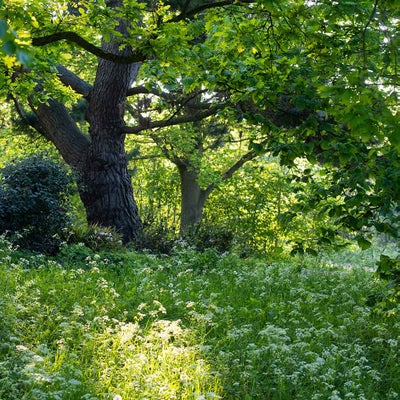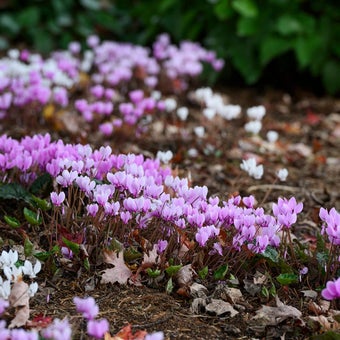
Quick facts
Buildings cast shade but without roots dry the soil to a lesser extent
Evergreen foliage is too dark for all but a few plants
Light varies with time of day – midday sun is strongest
Plants can detect shade by monitoring light composition
Plants respond to shade, to varying degrees, with avoidance and tolerance
Shade cast by trees is also associated with dry soil due to root action
Understanding shade in a garden
What is shade?
Shade is the blocking of sunlight (in particular direct sunshine as opposed to diffuse light reflected from the sky) by any object, and also the shadow created by that object. To grow healthy plants in shady areas, it is important to match the degree of shade that a plant needs or will tolerate with available light. Unfortunately very few plants will thrive where shade is very dense, particularly when coupled with a dry impoverished soil.
What does shade do?
All green plants depend on sunlight to manufacture the sugars that go to providing energy for the plant and for making the organic molecules that make up plants. Shade leads to lower sugar production and reduced growth and flowering and ultimately, in plants ill adapted to shade, death.
Plants can ‘measure’ shade by using that can detect far red and blue light and modify their growth habit in proportion to the degree of shade.
Plants can be considered as ‘shade avoiders’ and ‘shade toleraters’, to a greater or lesser degree. Sunlight is a mixture of wavelengths but the presence of shade alters the balance of colours which sophisticated systems within plants can measure and alter their growth according to the shade that they encounter.
Changes in red and blue light caused by the effects of shade in a garden trigger shade avoiders to elongate their stems and try to grow into more light above structures and bigger plants. Shade avoiders seldom make good plants for shady areas of the garden. A typical example is of most climbers, a plant form well adapted to clamber over obstacles to grow into the light. Although climbers are not well suited to shade there are some that can be used on east and north facing walls where there is little or no direct sunlight.
Amongst other changes, shade tolerators typically grow broader but thinner leaves with raised content when grown in shade making them better adapted to the conditions.
Types of shade
- Full sun: More than six hours of direct sun per day at midsummer.
- Light shade: A site that is open to the sky, but screened from direct sunlight by an obstacle, such as a high wall or group of trees.
- Partial or semi-shade: Three to six hours per day of direct sun at midsummer. Midday sun supplies considerably more light than morning or evening sun and sites illuminated at the middle of the day might be considered to be in light shade. Semi-shade is a term often used by writers but not defined. It is likely to mean a situation in half sun and half shade where there is some direct sun but possibly for less than half the hours of daylight.
- Dappled shade: Mainly reflected or diffused light, for example through fairly open tree canopies all day. Dappled shade can approximate to light or open shade where sunlight filters through especially lightly branched and leaved trees such as silver birch.
- Moderate shade: A site receiving sunlight for two or three hours of direct sunlight each day at midsummer. In this case too midday sun supplies significantly more light and might almost be considered a form of partial shade.
- Deep or heavy shade: Usually under dense tree cover, e.g. beech, conifer hedges or overgrown shrubberies, and also overhanging buildings. In practical terms if a site receives less than two hours of direct sun per day, it must be considered to be heavy shade.
Working with shade
Some practical considerations when gardening in sun or shade;
- Full sun: Well-chosen plants with modest water requirements will thrive in full sun, but shade loving plants will usually only do well in sun if well-watered in summer. In winter full sun can be quite feeble and sun loving plants are often grown in front of white painted walls to maximise light.
- Light shade:Mulching after planting improves water retention, and combined with autumn rather than spring planting, allows some plants to establish more effectively over winter. Many plants that don’t insist on full sun will grow well in light shade but often with reduced flowering.
- Partial or semi-shade: Many sun loving plants will survive in partial shade but usually with markedly reduced flowering. Shade loving plants will thrive. In light shade pale mulches can be used to reflect useful quantities of light back up into the canopy.
- Dappled shade: Shade loving plants will perform well, but may need watering. The addition of plenty of well-rotted farmyard manure, garden compost or leafmould will help improve soil structure and aid establishment of plants, either dug in before planting or applied as mulch every year after planting.
- Moderate shade: Shade tolerant plant will grow in moderate shade but they are usually grown for foliage rather than flowers. If conditions are excessively dry or for prolonged periods, use pots to grow plants in keeping them well watered. Use a John Innes No 3 . Enliven pots with a mixture of seasonal bedding such as Impatiens, Begonia, winter-flowering pansy and polyanthus (all reliable in shade). Zantedeschia (arum lily), though often tender, looks dramatic against an evergreen backdrop and can be overwintered under glass. Very close to walls (within about 40cm (16ins)), conditions can be dry, especially if sheltered from the prevailing wind or under the eaves of buildings, so planting 45cm (18ins) away from house walls can help.
- Deep or heavy shade: Under conifers, especially Leyland cypress, or evergreen trees such as holly or holm oak, where it is dry and sheltered in summer and winter, often with dead needles and debris creating acidic conditions, it is likely that only a very limited selection of extremely shade tolerant plants will survive.
For specific plants to grow in a shady garden see our advice pages;
Climbers and wall shrubs for shade
Plants for under trees
Shade planting: annuals, bulbs and perennials
Shade planting: shrubs
Fruit and veg in shade
Fruit in shade
Redcurrants, whitecurrants and gooseberries, as well as fruit such as raspberries, blackcurrants and rhubarb which originate from woodland edges will produce reasonable crops in light shade or in partial shade where there is some midday sun in midsummer. However dappled, moderate or deep shade is unsuitable.
Morello cherries and William’s pears can crop moderately in light shade and are recommended for east and north facing walls. or fan trainedredcurrants, whitecurrants and gooseberries are also sometimes recommended for this position.
Apples, pears and plums prefer a more open position, but cooking apples that mature early can tolerate light shade.
Vegetables in shade
Beetroot, carrots (baby), chard, kale, kohl rabi, leaf salads,lettuce, peas, runner beans and spinach are all relatively tolerant of light shade. Sowing seeds in in bright conditions and then transplanting will get them off to an early start with an established root system.
Partial shade with some direct sun in midsummer can also be fairly successfully used to grow these vegetables.
References
Planting the Dry Shade Garden: The Best Plants for the Toughest Spot in Your Garden, by Graham Rice (Timber Press, 2011, ISBN 9781604691870)
Gardeners’ World: 101 Shade-Loving Plants by James Wickham (Random House & Ebury Publishing, 2008, ISBN 9781846074509)
These books are also made available through the RHS Lindley Library.





